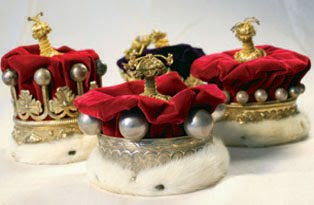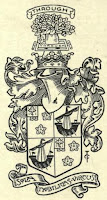THE HAMILTONS OF HAMWOOD OWNED 352 ACRES OF LAND IN COUNTY MEATH
HUGH HAMILTON (1572-1655) settled in Lisbane, County Down, during the reign of JAMES I, and was made a denizen of Ireland, 1616.
This Hugh Hamilton married, and had issue,
John, of Ballymenoch;
ALEXANDER, of whom presently;
Robert.
The second son,
ALEXANDER HAMILTON, of Killyleagh, County Down, wedded Jean, daughter of John Hamilton, of Belfast, and had issue,
HUGH, his heir;
Jane, married William Sloane, of Chelsea.
Mr Hamilton died in 1676, and was succeeded by his son,
HUGH HAMILTON (1664-1728), of Ballybredagh, County Down, who married Mary, sister of Robert Ross, of Rostrevor, County Down, and daughter of George Ross, of Portavo, by Ursula his wife, daughter of Captain Hans Hamilton, of Carnesure, and had issue (with three daughters), two sons,
George;
ALEXANDER.
The younger son,
ALEXANDER HAMILTON (1690-1768), of Knock, County Dublin, and Newtownhamilton, County Armagh, MP for Killyleagh, 1730-61, wedded Isabella, daughter of Robert Maxwell, of Finnebrogue, County Down, and had issue,
Hugh (Rt Rev), Lord Bishop of Ossory;
George, MP for Belfast, 1769-76;
CHARLES, of whom hereafter;
Anne.
The youngest son,
CHARLES HAMILTON (1738-1818), married Elizabeth, daughter of Crewe Chetwood, of Woodbrook, Queen's County, and had issue,
CHARLES, his heir;
Robert, of Liverpool;
George, of Quebec, and Hawkesbury, Canada;
William Henry;
John, of Liverpool;
Henrietta.
Mr Hamilton was succeeded by his eldest son,
CHARLES HAMILTON (1772-1857), of Hamwood, County Meath, who wedded, in 1801, Marianne Caroline, daughter of
William Tighe MP, of Rossana, County Wicklow, by Sarah his wife, only child of Sir William Fownes Bt, of
Woodstock, County Kilkenny, and had issue,
CHARLES WILLIAM, his heir;
William Tighe;
Frederick John Henry Fownes;
Sarah; Mary; Caroline Elizabeth.
Mr Hamilton was succeeded by his eldest son,
CHARLES WILLIAM HAMILTON JP (1802-80), of Hamwood, who espoused, in 1841, Letitia Charlotte, eldest daughter of William Henry Armstrong MP, of Mount Heaton, King's County, and had issue,
CHARLES ROBERT, his heir;
Edward Chetwood;
Arthur, of Hollybrook.
Mr Hamilton was succeeded by his eldest son,
CHARLES ROBERT HAMILTON JP (1846-1913), of Hamwood, who married, in 1874, Louisa Caroline Elizabeth, daughter of Francis Richard Brooke, of Somerton, County Dublin, by his wife, the Hon Henrietta Monck, eldest daughter of 3rd Viscount Monck, and had issue,
Charles George (1875-77);
GERALD FRANCIS CHARLES, of whom hereafter;
Frederick Arthur (1880-1962);
Henry John;
Eva Henrietta; Letitia Marion; Amy Kathleen; Ethel Grace; Constance Louisa; Lilian Mary.
Mr Hamilton was succeeded by his eldest surviving son,
GERALD FRANCIS CHARLES HAMILTON JP (1877-1961), of Hamwood, who wedded firstly, in 1911, Violet Travers, daughter of Robert Craigie Hamilton, and had issue,
CHARLES ROBERT FRANCIS, his heir;
Esme Violet; Elizabeth Mary.
He married secondly, in 1949, Rosamund Mary, daughter of Maurice Bauer.
Mr Hamilton was succeeded by his son,
MAJOR CHARLES ROBERT FRANCIS HAMILTON (1918-2005), of Hamwood, who wedded, in 1958, Margaret Anne Lanfear, daughter of Captain Simon Ralph Fane Spicer, and had issue,
CHARLES RALPH, b 1960;
Annabel Honor, b 1959.
HAMWOOD HOUSE, Dunboyne, County Meath, is a small Palladian house of the 1764, with a central block joined to little octagonal ‘pepper-pot’ wings by elegantly curved sweeps.
Unusually, one wing contains the main entrance, since the house (as originally built) was reputedly so cold that the family decided to place the hall door as far away from the main rooms as possible.
The removal of the front entrance from the main block creates an interesting internal arrangement with a double drawing-room, unusual in a house of this size.
There is good late-18th century decoration and an interesting family collection, including the intriguing drawings and paintings of Caroline Hamilton.
Hamwood’s builder, Charles Hamilton, acted as land agent for the Dukes of Leinster whose principal seat, Carton, is nearby; and the Duke generously gave the Hamiltons a present of the impressive fights of granite steps leading to the doors in the end pavilions.
Successive generations of the family acted as the Leinsters' agents until the present owner's husband, Charles Hamilton (1918-2005), retired in the 1970s.
*****
MRS ANNE HAMILTON, Major Charles Hamilton's widow, died suddenly on the 4th December, 2013.
She represented the family at a function in Farmleigh House in 2012 honouring the Irish team at the 1948 Olympics in London.
A relative, Letitia Hamilton, was the only Irish medal-winner at those Games, for her painting of a scene at the Meath Hunt Point-to-Point races.
Anne Hamilton was born Anne Spicer in Wiltshire, England. Her father, Ralph Spicer, had married Mary Graham, whose family lived at Spye Park, near Bromham, Wiltshire, since 1855.
The Grahams were originally from Lisburn in Northern Ireland, involved in the linen industry.
Anne and her siblings holidays at their grandparents’ place at Sallins every summer, and to escape the rationing and austerity England in the years following the 2nd World War, her mother moved them to Carnew in County Wicklow.
In 1958, Anne married Charles Hamilton, who had served in the 2nd World War.
He was a farm estate manager and they lived in County Galway for a period before returning to Hamwood in 1963, following the death of Charles’ father, who was the land agent at Carton House.
Charles also managed the Slane Castle estate for a period.
At Hamwood, they were involved in bloodstock breeding and a pure-bred Charolais herd.
The gardens were also a great treasure and open to the public.
In an interview for the Irish Life and Lore Collection at South Dublin Libraries, Mrs Hamilton was critical of how the Irish Land Commission had broken up large estates and the manner in which they allowed fine houses to decay.
In recent years, she continued to open the gardens and house at Dunboyne to the public.
Mrs Hamilton was survived by her son, Charles, of London, and Annabel, of Paris, and her sister in County Cork.
Her funeral service took place at St Peter’s parish church, Dunboyne, County Meath, followed by burial in the adjoining graveyard.
First published in November, 2017. Select bibliography: Irish historic Houses Association.

























